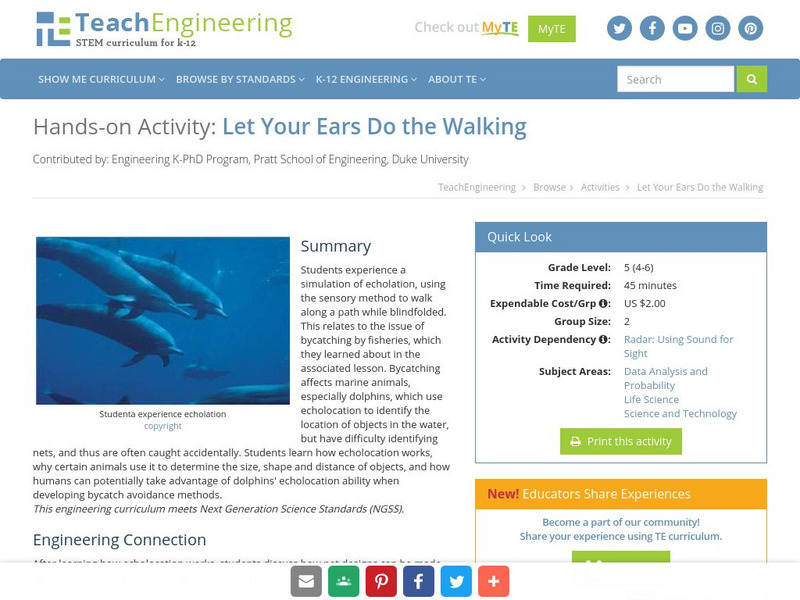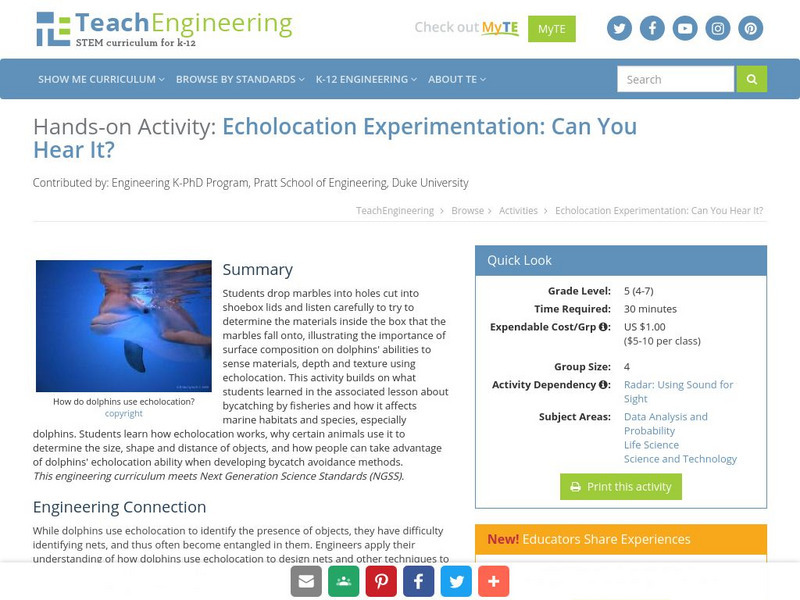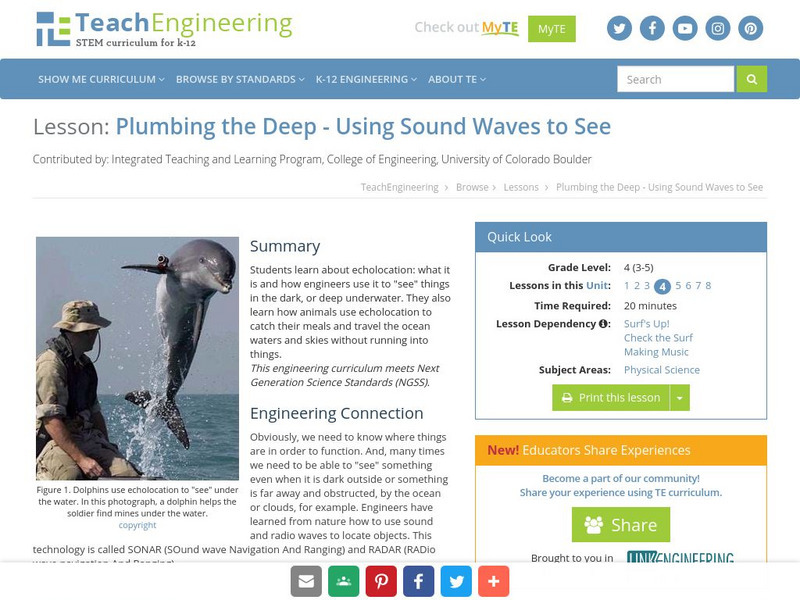Hi, what do you want to do?
Curated OER
Mammals Crossword
In this mammals worksheet, students complete a crossword puzzle with 37 questions about characteristics, behavior and types of mammals.
Curated OER
Spelling List 12: Sight Words, "ure" Pattern, and Academic Vocabulary
In this spelling list worksheet, students practice spelling words that are sight words, ure pattern, and vocabulary. Students practice spelling 21 words total.
Curated OER
Come to Mommy
Fourth graders participate in a simple experiment to illustrate the concept of mother bats identifying their young. They sniff stickers in order to imitate the behavior of mother bats in the wild.
Curated OER
Hunting For Bats
Fourth graders investigate the adaptations that occur in bats. The benefits of adaptations are discussed with them and the probability of survival is measured. The specific adaptations are written and defined.
Curated OER
What Shape Is It?
Students predict the shape of an unknown object by bouncing a ball on it. For this physics lesson, students relate this activity to how dolphins use echo-location to navigate. They analyze their lab result and discuss findings.
Curated OER
Dolphin Documentary
Students use their knowledge of dolphin natural history to create a "movie."
TeachEngineering
Teach Engineering: Biomimicry: Echolocation in Robotics
Students use ultrasonic sensors and LEGO MINDSTORMS NXT robots to emulate how bats use echolocation to detect obstacles. They measure the robot's reaction times as it senses objects at two distances and with different sensor threshold...
PBS
Pbs Teachers: Scientific American: Calls of the Wild: Bats and Echolocation
Explore bats' navigation systems by experimenting with echolocation. Approximate an object's distance by analyzing reflected sound waves, measuring the delay in sound and calculating the ratio to the speed of sound.
TeachEngineering
Teach Engineering: Echolocation in Action!
In this activity, students will experience echolocation themselves. They actually try echolocation by wearing blindfolds while another student makes snapping noises in front of, behind, or to the side of them.
Alabama Learning Exchange
Alex: Echolocation Stations: Exploring Sound
During this lesson students will have the opportunity to explore sound. This lesson should be taught during an ongoing unit about whales. Students will navigate different websites to learn more about whales and sound. This lesson is...
TeachEngineering
Teach Engineering: Sound for Sight
Echolocation is the ability to orient by transmitting sound and receiving echoes from objects in the environment. As a result of a Marco-Polo type activity and subsequent lesson, students learn basic concepts of echolocation. They use...
Unite for Literacy
Unite for Literacy: Mystic Aquarium: Bats Dare to Be Different
Read about bats' characteristics, habitat, diet, behavior, and their unique hearing ability called echolocation. You'll also learn why they are important to humans, the threats they face, and what you can do to help them. Includes audio...
NOAA
Noaa: Whales, Dolphins, and Porpoises (Order Cetacea)
Learn about the over 70 species of Cetaceans, or whales, dolphins, and porpoises in the ocean. Read about their behaviors, strandings, and their special sense: echolocation
TeachEngineering
Teach Engineering: Let Your Ears Do the Walking
In the previous lesson, students learned about the issue of bycatching by fisheries and how it affects marine habitats. Dolphins are one of the main species affected by bycatching. Dolphins use echolocation to identify the location of...
TeachEngineering
Teach Engineering: Can You Hear It?
In the previous lesson, students learned about the issue of bycatching by fisheries and how it affects marine habitats. Dolphins are one of the main species affected by bycatching. While dolphins can use echolocation to identify the...
TeachEngineering
Teach Engineering: Plumbing the Deep: Using Sound Waves to See
In this instructional activity, students learn about echolocation: what it is and how engineers use it to "see" things in the dark, or deep underwater. Also, they learn how animals use echolocation to catch their dinner and travel the...
Library of Congress
Loc: Everyday Mysteries: Why Do Bats Live in Caves?
Ever wonder why bats live in caves? Or why bats don't fly into objects at night? This article describe why bats thrive in the protected shelter a cave provides. It also explains how bats use echolocation to locate food and avoid obstacles.
TED Talks
Ted: Ted Ed: How Whales Breathe, Communicate and Fart With Their Faces
Comparative anatomist Joy Reidenberg explains how majestic whales "fart with their face" (a process more formally known as echolocation) to send their unique sounds through the water. [6:24]
PBS
Pbs Teachers:borneo: A Batty Mapping Method
Explore how bats use echolocation to find prey by using echoes to map the direction and distance to various echo sources in their surroundings. Determine the minimum distance at which an echo can be heard and the distance to an echo source.
Discovery Education
Animal Planet: Atlantic Bottlenose Dolphin
This site provides information about the Atlantic Bottlenose Dolphin including what they eat and how they find food using a process called echolocation.
CK-12 Foundation
Ck 12: Physical Science: Ultrasound
[Free Registration/Login may be required to access all resource tools.] What ultrasound and echolocation are, and how sonar and ultrasonography are used.
Natural History Museum
Natural History Museum: The Secret Life of Bats: Bat Senses
Part of an online exhibit on bats, this section focuses on bat senses: sight, olfaction (smell), echolocation, and hearing.
Enchanted Learning
Enchanted Learning: Sperm Whale
This clear and concise resource on sperm whales includes a diagram and information on its diet and echolocation.
PBS
Pbs Teachers: Scientific American: Expedition Panama: Echoes in the Night
Explore your prior knowledge about bats and investigate bats' use of echolocation to identify and catch prey. Design a game like "Marco Polo" to demonstrate echolocation.
Other popular searches
- Echolocation Bats
- Whale Echolocation
- Dolphin Echolocation
- Echolocation Activities
- Ocean Echolocation
- Bats and Echolocation
- Science; Echolocation
- Echolocation Whales
- Long Nosed Bat Echolocation
- Echolocation in Bats
- Science Echolocation
- Bat Echolocation Activities

















